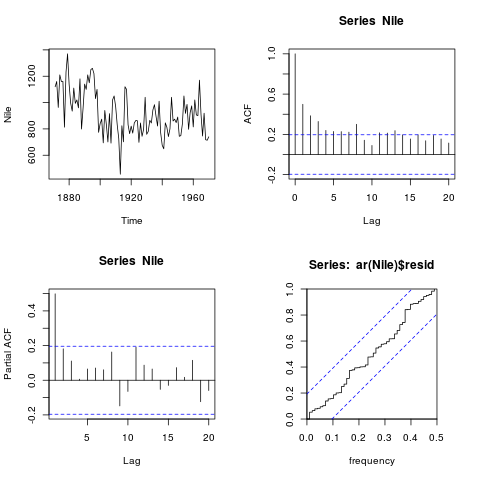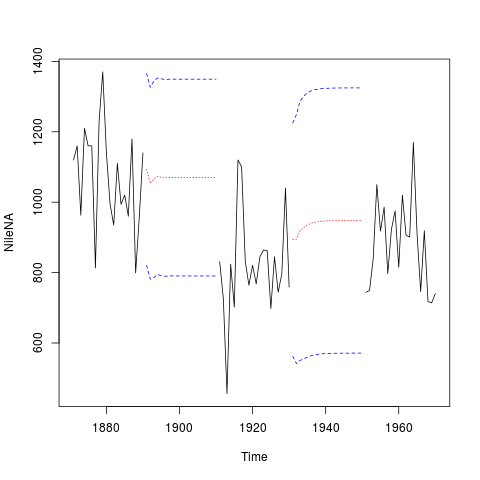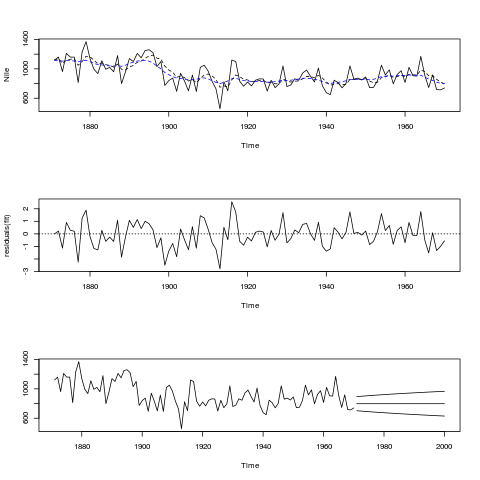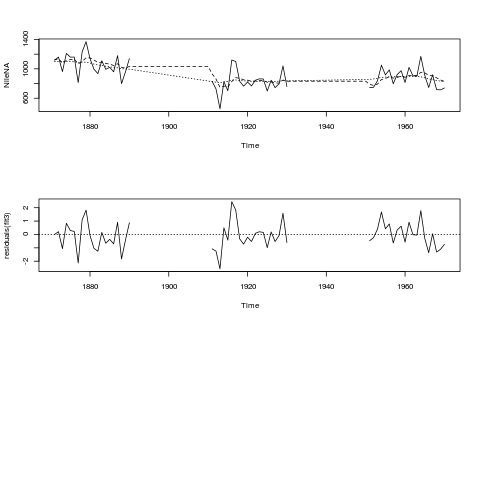Supported by Dr. Osamu Ogasawara and  providing providing  . . |
|
Last data update: 2014.03.03 |
Flow of the River NileDescriptionMeasurements of the annual flow of the river Nile at Aswan (formerly
UsageNile FormatA time series of length 100. SourceDurbin, J. and Koopman, S. J. (2001) Time Series Analysis by State Space Methods. Oxford University Press. http://www.ssfpack.com/DKbook.html ReferencesBalke, N. S. (1993) Detecting level shifts in time series. Journal of Business and Economic Statistics 11, 81–92. Cobb, G. W. (1978) The problem of the Nile: conditional solution to a change-point problem. Biometrika 65, 243–51. Examples
require(stats); require(graphics)
par(mfrow = c(2, 2))
plot(Nile)
acf(Nile)
pacf(Nile)
ar(Nile) # selects order 2
cpgram(ar(Nile)$resid)
par(mfrow = c(1, 1))
arima(Nile, c(2, 0, 0))
## Now consider missing values, following Durbin & Koopman
NileNA <- Nile
NileNA[c(21:40, 61:80)] <- NA
arima(NileNA, c(2, 0, 0))
plot(NileNA)
pred <-
predict(arima(window(NileNA, 1871, 1890), c(2, 0, 0)), n.ahead = 20)
lines(pred$pred, lty = 3, col = "red")
lines(pred$pred + 2*pred$se, lty = 2, col = "blue")
lines(pred$pred - 2*pred$se, lty = 2, col = "blue")
pred <-
predict(arima(window(NileNA, 1871, 1930), c(2, 0, 0)), n.ahead = 20)
lines(pred$pred, lty = 3, col = "red")
lines(pred$pred + 2*pred$se, lty = 2, col = "blue")
lines(pred$pred - 2*pred$se, lty = 2, col = "blue")
## Structural time series models
par(mfrow = c(3, 1))
plot(Nile)
## local level model
(fit <- StructTS(Nile, type = "level"))
lines(fitted(fit), lty = 2) # contemporaneous smoothing
lines(tsSmooth(fit), lty = 2, col = 4) # fixed-interval smoothing
plot(residuals(fit)); abline(h = 0, lty = 3)
## local trend model
(fit2 <- StructTS(Nile, type = "trend")) ## constant trend fitted
pred <- predict(fit, n.ahead = 30)
## with 50% confidence interval
ts.plot(Nile, pred$pred,
pred$pred + 0.67*pred$se, pred$pred -0.67*pred$se)
## Now consider missing values
plot(NileNA)
(fit3 <- StructTS(NileNA, type = "level"))
lines(fitted(fit3), lty = 2)
lines(tsSmooth(fit3), lty = 3)
plot(residuals(fit3)); abline(h = 0, lty = 3)
Results
R version 3.3.1 (2016-06-21) -- "Bug in Your Hair"
Copyright (C) 2016 The R Foundation for Statistical Computing
Platform: x86_64-pc-linux-gnu (64-bit)
R is free software and comes with ABSOLUTELY NO WARRANTY.
You are welcome to redistribute it under certain conditions.
Type 'license()' or 'licence()' for distribution details.
R is a collaborative project with many contributors.
Type 'contributors()' for more information and
'citation()' on how to cite R or R packages in publications.
Type 'demo()' for some demos, 'help()' for on-line help, or
'help.start()' for an HTML browser interface to help.
Type 'q()' to quit R.
> library(datasets)
> png(filename="/home/ddbj/snapshot/RGM3/R_rel/result/datasets/Nile.Rd_%03d_medium.png", width=480, height=480)
> ### Name: Nile
> ### Title: Flow of the River Nile
> ### Aliases: Nile
> ### Keywords: datasets
>
> ### ** Examples
>
> require(stats); require(graphics)
> par(mfrow = c(2, 2))
> plot(Nile)
> acf(Nile)
> pacf(Nile)
> ar(Nile) # selects order 2
Call:
ar(x = Nile)
Coefficients:
1 2
0.4081 0.1812
Order selected 2 sigma^2 estimated as 21247
> cpgram(ar(Nile)$resid)
> par(mfrow = c(1, 1))
> arima(Nile, c(2, 0, 0))
Call:
arima(x = Nile, order = c(2, 0, 0))
Coefficients:
ar1 ar2 intercept
0.4096 0.1987 919.8397
s.e. 0.0974 0.0990 35.6410
sigma^2 estimated as 20291: log likelihood = -637.98, aic = 1283.96
>
> ## Now consider missing values, following Durbin & Koopman
> NileNA <- Nile
> NileNA[c(21:40, 61:80)] <- NA
> arima(NileNA, c(2, 0, 0))
Call:
arima(x = NileNA, order = c(2, 0, 0))
Coefficients:
ar1 ar2 intercept
0.3622 0.1678 918.3103
s.e. 0.1273 0.1323 39.5037
sigma^2 estimated as 23676: log likelihood = -387.7, aic = 783.41
> plot(NileNA)
> pred <-
+ predict(arima(window(NileNA, 1871, 1890), c(2, 0, 0)), n.ahead = 20)
> lines(pred$pred, lty = 3, col = "red")
> lines(pred$pred + 2*pred$se, lty = 2, col = "blue")
> lines(pred$pred - 2*pred$se, lty = 2, col = "blue")
> pred <-
+ predict(arima(window(NileNA, 1871, 1930), c(2, 0, 0)), n.ahead = 20)
> lines(pred$pred, lty = 3, col = "red")
> lines(pred$pred + 2*pred$se, lty = 2, col = "blue")
> lines(pred$pred - 2*pred$se, lty = 2, col = "blue")
>
> ## Structural time series models
> par(mfrow = c(3, 1))
> plot(Nile)
> ## local level model
> (fit <- StructTS(Nile, type = "level"))
Call:
StructTS(x = Nile, type = "level")
Variances:
level epsilon
1469 15099
> lines(fitted(fit), lty = 2) # contemporaneous smoothing
> lines(tsSmooth(fit), lty = 2, col = 4) # fixed-interval smoothing
> plot(residuals(fit)); abline(h = 0, lty = 3)
> ## local trend model
> (fit2 <- StructTS(Nile, type = "trend")) ## constant trend fitted
Call:
StructTS(x = Nile, type = "trend")
Variances:
level slope epsilon
1427 0 15047
> pred <- predict(fit, n.ahead = 30)
> ## with 50% confidence interval
> ts.plot(Nile, pred$pred,
+ pred$pred + 0.67*pred$se, pred$pred -0.67*pred$se)
>
> ## Now consider missing values
> plot(NileNA)
> (fit3 <- StructTS(NileNA, type = "level"))
Call:
StructTS(x = NileNA, type = "level")
Variances:
level epsilon
685.8 17899.8
> lines(fitted(fit3), lty = 2)
> lines(tsSmooth(fit3), lty = 3)
> plot(residuals(fit3)); abline(h = 0, lty = 3)
>
>
>
>
>
> dev.off()
null device
1
>
|



